Basic AI Chatbot Pricing: A simple chatbot that can answer questions about a product or service might cost around $10,000 to develop.
Read More

Here's the reality: McKinsey stated that 78% of organizations have adopted AI in at least one function. And Deloitte predicts a quarter of enterprises will use autonomous AI agents by 2025. The pace isn't slowing down, and hesitation is costing companies more than just market share, it's costing relevance.
So, let's cut to it. If you want to stay competitive, you need to train AI models that actually solve business problems, not just run flashy demos. That's where AI model development comes into play. Done right, it fuels sharper decision-making, boosts efficiency, and gives your company a durable edge. Done wrong, it drains budgets and slows innovation.
In 2025, leaders are asking more than how do you train AI models? They're asking how to:
This guide gives you a step-by-step blueprint, from defining your problem to choosing the right stack, controlling costs, and avoiding rookie mistakes. We'll also touch on when to lean on an AI development company for scale and speed.
Think of this as your shortcut to not just learning how to train AI models, but how to train smarter ones that deliver ROI your board will actually care about.
At its core, AI model training is the process of teaching a system how to make decisions. You feed it data, the algorithms recognize patterns, and over time, the model learns how to respond intelligently.
For leaders, the real question isn't what is training of AI models? It's how do you train AI models in a way that creates measurable business value. That's the difference between a system that predicts customer churn accurately and one that becomes a very expensive science project.
Here's the simplest way to understand it:
In 2025, training isn't just about brute force computing power. It's about strategy. When companies train AI models with contextual data, they add depth and accuracy, making predictions feel closer to real-world logic instead of shallow guesses.
The truth is, knowing how AI models are trained isn't enough anymore. The leaders winning with AI understand:
This is where external expertise can help. Partnering with a custom software development company ensures you're not just experimenting but actually building models that work in real business contexts. Similarly, specialized AI consulting services can guide executives on AI model training strategies that align with long-term goals.
Instead of asking only how do you train AI models, the smarter question for 2025 is: how do you train them to deliver real, sustainable ROI.
Don’t wait for tomorrow when the future is already here. Let’s get your AI journey started today.
Talk to Our AI ExpertsEvery executive is hearing the buzz, but here's the truth: companies that train smarter AI models aren't chasing trends, they're building long-term competitive advantage. In 2025, it's no longer about if you should invest, but why waiting is the riskiest move of all.
This is why forward-thinking organizations turn to enterprise AI solutions scale training safely and reliably across departments.
Leaders often ask: "Is the investment worth it?" The answer is a resounding yes when models are aligned with business goals. Companies that strategically train AI models can see:
For growing businesses, working with an AI app development company ensures that trained models don't sit idle in labs but actually power apps and services that drive revenue.
Ignoring these shifts could leave your business behind competitors who are already optimizing their AI model training strategies for smarter growth.
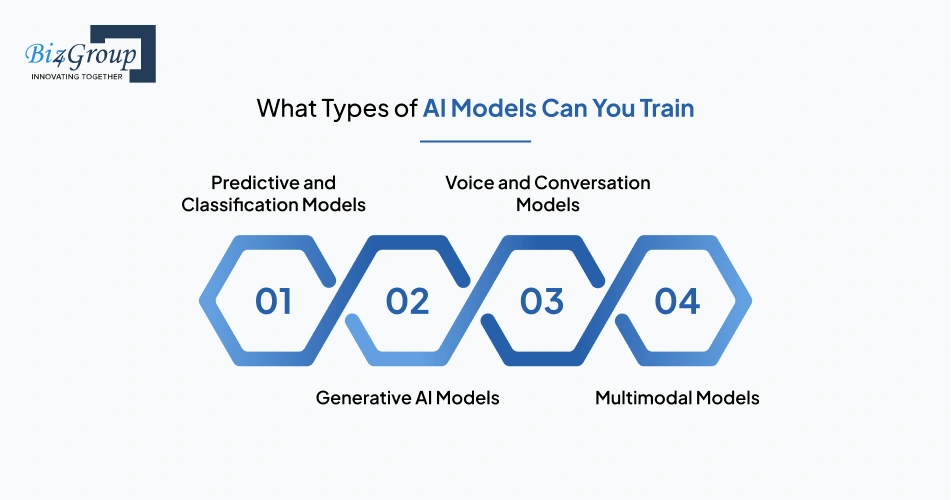
Not all models are created equal. When leaders talk about training of AI models, they're really talking about a wide spectrum of possibilities. Choosing the right one isn't about shiny tech; it's about aligning the model with your company's goals.
These are the bread and butter of AI model training. They analyze historical data to forecast future outcomes like predicting customer churn or identifying fraud. If you're asking how do you train AI models that reduce risk, this is usually where you start.
Here's where creativity meets scale. How to train generative AI models has become a boardroom discussion, not just an R&D experiment. These models generate content, code, and even product designs. Partnering with a top software development company in USA ensures these systems don't just create novelty but deliver business-ready value.
Voice assistants, customer service bots, and digital agents are booming. Companies now ask how to train AI voice models that sound natural and solve real problems. Working with an AI chatbot development company helps ensure these systems actually improve customer engagement rather than frustrate users with robotic replies.
In 2025, AI model training isn't limited to text or speech. Multimodal models combine text, images, audio, and video, unlocking new opportunities in healthcare, retail, and enterprise operations. This is where AI model training strategies evolve from "single skill" to "multi-talented digital worker."
The takeaway is simple: not every company needs the same type of model, but every company needs the right one. Whether you're exploring how to train AI voice models for customer engagement or experimenting with how to train generative AI models for product innovation, the choice should always circle back to business impact. In the next section, we'll break down the benefits of training AI models so you can see why executives across industries are betting big on smarter systems in 2025.
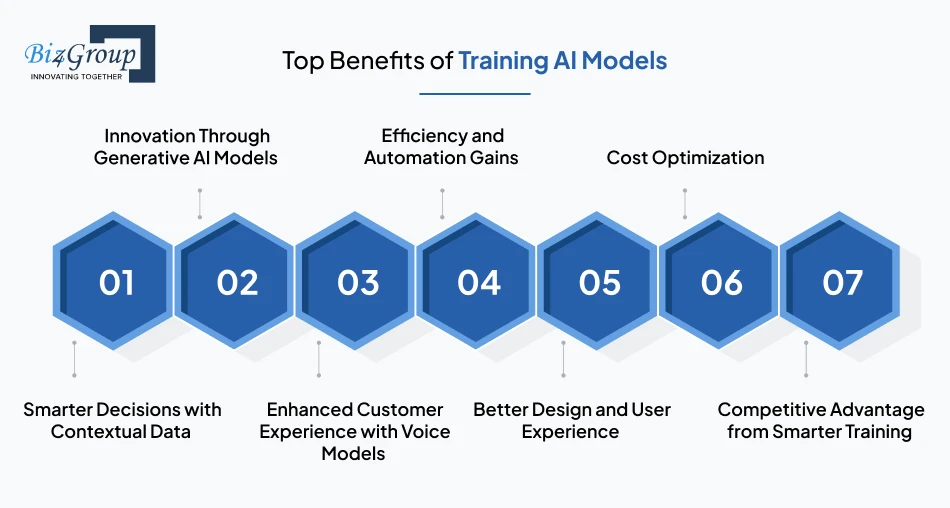
When companies train AI models, they are not just investing in technology, they are investing in a stronger competitive position. In 2025, the training of AI models has become the difference between thriving enterprises and those struggling to keep up.
|
Benefit |
Why It Matters in 2025 |
Key Outcomes |
|
Smarter Decisions with Contextual Data |
Using how to train AI models with contextual data ensures predictions reflect real-world scenarios instead of shallow guesses. |
• Accurate forecasting across finance, sales, and supply chain |
|
Innovation Through Generative AI Models |
Companies asking how to train generative AI models are redefining product development and creativity. Working with an AI product development company ensures innovation translates into market-ready solutions. |
• AI-generated content, designs, and code |
|
Enhanced Customer Experience with Voice Models |
Businesses focusing on how to train AI voice models create natural, responsive interactions. |
• 24/7 customer support |
|
Efficiency and Automation Gains |
With structured training of AI models, repetitive tasks move from human desks to smart systems. |
• Lower operational costs |
|
Better Design and User Experience |
Smart design choices come from smart models. By applying AI for UX design, companies ensure every user touchpoint feels seamless. |
• Personalized digital experiences |
|
Cost Optimization |
Learning how much it costs to develop and train AI models in the cloud helps businesses budget smarter. |
• Transparent cost planning |
|
Competitive Advantage from Smarter Training |
Organizations that train smarter AI models consistently outperform laggards. |
• Faster product launches |
The ROI is undeniable. From sharper insights to stronger customer experiences, businesses that commit to AI model training are pulling ahead. The next step is understanding the step-by-step roadmap to train AI models in 2025, so you can put these benefits into practice with confidence.
From productivity to profit, the right AI unlocks more than you can imagine.
Discover Your AI Advantage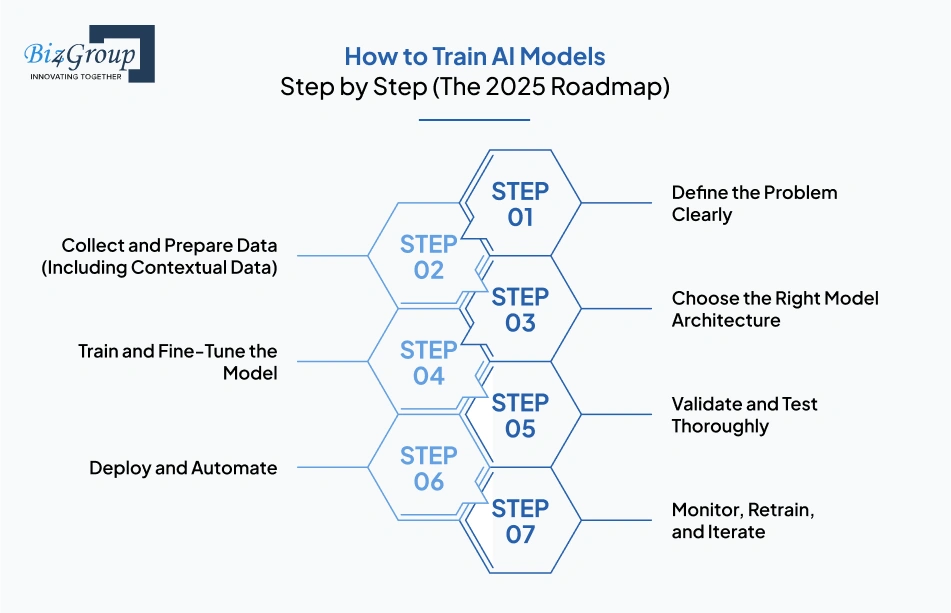
Training an AI system isn't just about feeding it data and hoping for the best. To train AI models that deliver ROI, you need a structured process. Here's the modern 2025 playbook.
Every successful project starts with focus. Before you dive into AI model training, outline the exact business challenge you want to solve.
Clear objectives prevent wasted resources and help align training of AI models with measurable outcomes.
This is where most projects succeed or fail. Knowing how to train AI models with contextual data makes all the difference. Raw data needs cleaning, labeling, and enriching with real-world context.
Not every challenge requires the same model. Understanding how AI models are trained means matching the right architecture to the right task.
Working with a trusted partner for MVP development ensures you test the right model before scaling.
This is where algorithms meet computing power. To train smarter AI models, techniques like fine-tuning, reinforcement learning, or LoRA come into play.
Validation ensures that your system isn't just memorizing data but actually learning. This step reduces risks in production.
Once validated, the model needs to move into production where it creates value daily. Automating this cycle ensures continuous improvement.
Even the best-trained models drift over time. Continuous monitoring ensures systems stay accurate and relevant.
The roadmap may look technical at first glance, but in reality, it's a business framework. Companies that follow these steps to train AI models reduce risk, control costs, and maximize ROI.
Choosing the right stack is critical. The tools you select determine how efficiently you can train AI models, control costs, and deploy them at scale. Here's the modern stack decision-makers should know.
|
Layer |
Tools / Technology |
Description |
|
Frontend |
React, Angular, Vue, Flutter |
The presentation layer where users interact with systems powered by trained models. Ideal for dashboards, apps, or business app development using AI. |
|
Backend |
Handles logic, APIs, and connections between trained models and user-facing products. Critical for integrating AI model training strategies into enterprise workflows. |
|
|
Data Layer |
AWS S3, Google BigQuery, Azure Data Lake, Delta Lake |
Stores raw and contextual datasets used for training of AI models. Reliable storage ensures quality data pipelines. |
|
Data Prep & Labeling |
Label Studio, Snorkel, Gretel, Amazon SageMaker Ground Truth |
Tools for cleaning, labeling, and generating synthetic datasets, especially useful for how to train AI models with contextual data. |
|
Core Frameworks |
PyTorch, TensorFlow, JAX, Hugging Face Transformers |
Libraries and frameworks to actually train AI models. Support everything from generative AI to voice systems. |
|
Model Training & Orchestration |
Ray, PyTorch Lightning, Vertex AI, Azure ML, SageMaker |
Scales experiments, manages distributed training, and optimizes compute resources. |
|
Generative AI & Fine-tuning |
Hugging Face PEFT, LoRA, TRL, OpenAI fine-tuning APIs |
Specialized for how to train generative AI models without needing massive hardware investments. |
|
Voice / Conversation |
Whisper, NVIDIA NeMo, Coqui, Speechly |
Enables how to train AI voice models for customer support, call centers, and digital agents. |
|
MLOps & Deployment |
MLflow, Kubeflow, Docker, Kubernetes, KServe |
Streamlines moving trained models into production with monitoring, CI/CD, and automated retraining. |
|
Monitoring & Cost Control |
Arize, WhyLabs, Prometheus, Auto-scaling cloud GPUs |
Ensures AI model training runs stay efficient, cost-effective, and reliable. |
|
Security & Compliance |
Vault, KMS, Data Loss Prevention tools |
Protects sensitive datasets during training of AI models and ensures compliance with regulations. |
If scaling internally feels overwhelming, working with AI integration services can simplify connecting trained models to your existing systems. And for companies needing specialized talent quickly, hire AI developers is often the fastest way to build and deploy. With these layers in place, businesses can train smarter AI models, deploy them faster, and maximize ROI.
Here's the question every executive asks first: how much does it cost to develop and train AI models in the cloud? The answer is - it depends. In 2025, companies can expect a range anywhere from $30,000 for a basic prototype to over $500,000 for enterprise-grade AI model training, but the actual number varies based on data size, complexity, and deployment needs.
|
Feature / Stage |
Estimated Cost Range (2025) |
Notes |
|
Data Collection & Preparation |
$10,000 – $80,000 |
Covers gathering, cleaning, labeling, and enriching contextual datasets. Clean data is critical for training of AI models. |
|
Model Selection & Architecture Setup |
$5,000 – $50,000 |
Costs vary depending on frameworks used (PyTorch, TensorFlow, Hugging Face) and project scope. |
|
Core Training Runs (Cloud Compute) |
$15,000 – $200,000 |
Cloud GPUs/TPUs drive most of the expense. Generative AI models and AI voice models consume significantly more compute. |
|
Fine-Tuning & Optimization |
$5,000 – $60,000 |
Includes LoRA, RLHF, and parameter-efficient methods to train smarter AI models without overspending. |
|
Validation & Testing |
$5,000 – $40,000 |
Ensures reliable results, checks for bias, and avoids drift before deployment. |
|
Deployment & Integration |
$10,000 – $70,000 |
Connecting trained models to apps. Many firms partner with a software development company in Florida for seamless integration. |
|
Monitoring & Maintenance |
$8,000 – $60,000 annually |
Covers retraining cycles, real-time monitoring, and compliance safeguards. |
|
Business App Layer |
$5,000 – $50,000 |
Adding intelligent features into user-facing systems. Business app development using AI helps ensure trained models actually deliver ROI. |
Several elements influence what you'll spend to train AI models effectively:
Beyond the obvious compute and storage, hidden expenses often catch companies by surprise during AI model training:
Smart leaders ask not just "how do you train AI models" but "how do you do it without breaking the budget." Effective cost optimization in training of AI models includes:
Costs in AI model training will always vary, but businesses that plan for factors, anticipate hidden costs, and optimize infrastructure can stay in control. The next section will cover the common pitfalls when training AI models and more importantly, how to avoid them.
The returns speak louder than the numbers. Let’s find the right cost-optimized path for you.
Get a Custom AI Cost Plan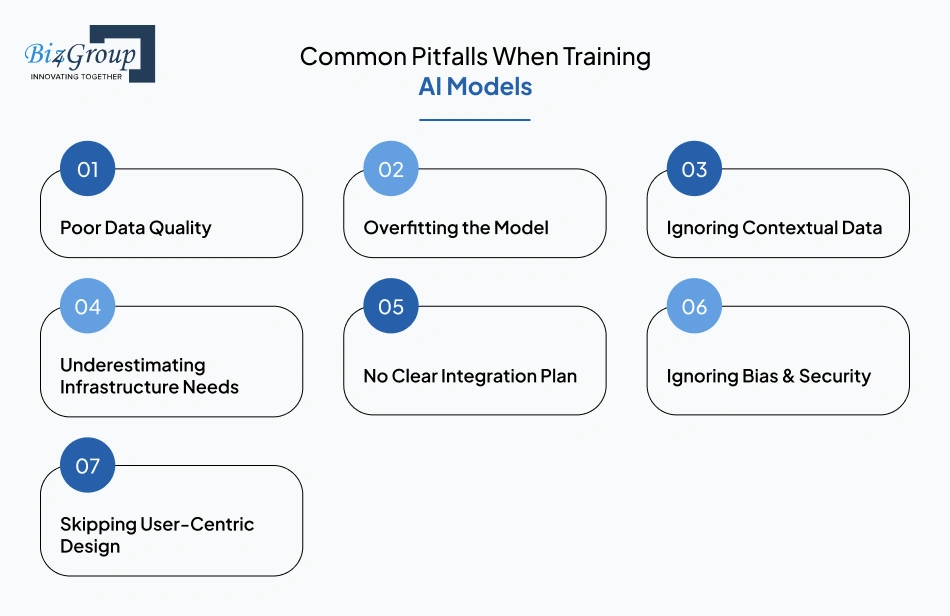
Even the smartest executives can stumble when they train AI models. The good news? Most mistakes are predictable and avoidable. Here's what to watch out for in 2025.
|
Pitfall |
Impact on AI Model Training |
How to Dodge It |
|
Poor Data Quality |
Garbage in, garbage out. Low-quality or mislabeled data ruins the training of AI models before they even start. |
Invest in structured pipelines, labeling, and contextual datasets. Strong UI/UX design for data interfaces reduces human error. |
|
Overfitting the Model |
A model that performs perfectly in training but fails in production. |
Use validation/testing splits, regularization, and continuous retraining. Always ask: how do you train AI models that generalize, not memorize? |
|
Ignoring Contextual Data |
Models make shallow predictions that miss the bigger picture. |
Prioritize how to train AI models with contextual data so outputs align with real-world logic. |
|
Underestimating Infrastructure Needs |
Underpowered compute leads to failed runs, spiraling timelines, and wasted budget. |
Choose the right cloud GPUs/TPUs. Partner with experts or an AI agent team when scaling to enterprise levels. |
|
No Clear Integration Plan |
Trained models sit idle, never powering real apps. |
Plan deployment early. Build them into a AI conversation app or enterprise workflow to show tangible ROI. |
|
Ignoring Bias & Security |
Models amplify bias or leak sensitive data, leading to compliance issues. |
Bake in monitoring, audits, and fairness testing as part of AI model training strategies. |
|
Skipping User-Centric Design |
Models technically "work" but frustrate end-users, killing adoption. |
Incorporate feedback loops and align with UI/UX design best practices for seamless user experiences. |
Training smarter isn't about avoiding mistakes, it's about anticipating them. Companies that spot these pitfalls early set themselves up to train smarter AI models that don't just function but actually deliver value.
When decision-makers look for proof, real projects speak louder than promises. Biz4Group has been at the forefront of AI model training by transforming ideas into products that work in the real world. Two standout examples from our portfolio illustrate how we help businesses train AI models that drive measurable value.

Stratum 9 began as a traditional book but evolved into a skill development platform powered by AI. Biz4Group built a solution that trained AI models to personalize learning experiences, recommend content, and track user progress.
Our role included:
With Stratum 9, AI went beyond static learning and turned into a dynamic mentor.
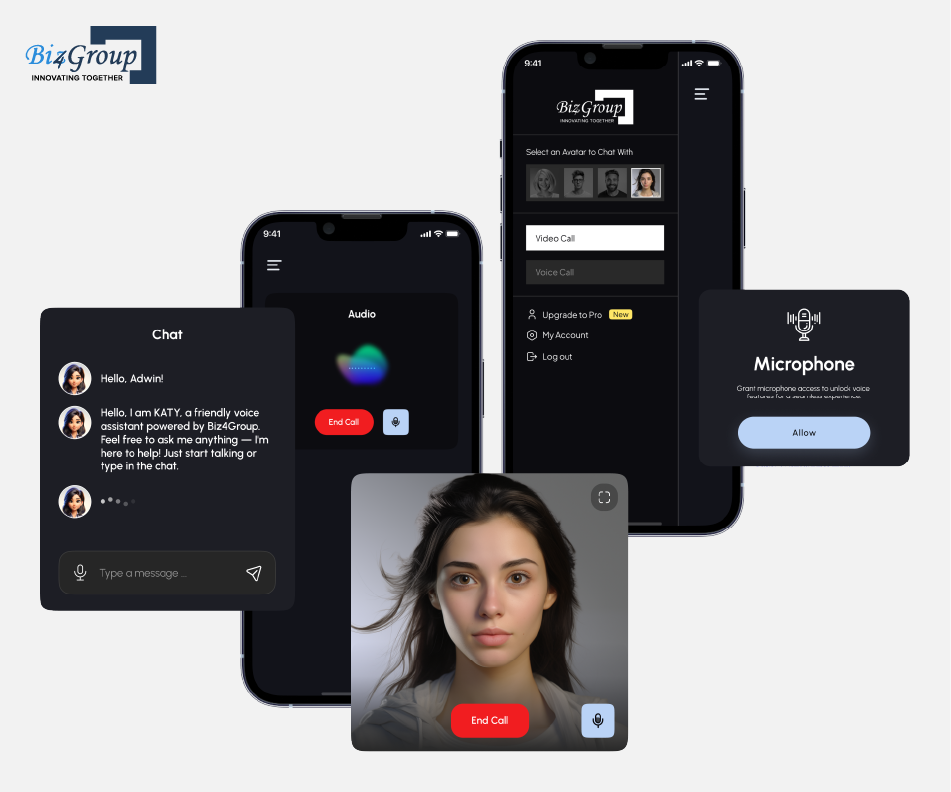
AI Wizard is an avatar-based AI companion built for interactive learning and personal assistance. Biz4Group engineered it to leverage AI model development and advanced AI training strategies so the companion could understand natural conversations, adapt to user input, and deliver contextual guidance.
Our contributions included:
With AI Wizard, we transformed what could have been a static digital assistant into a conversational partner that feels human-like, scalable, and practical.
From Stratum 9 to AI Wizard, Biz4Group builds models that deliver real-world impact.
Start Your AI Project TodayBy now, you've seen that in 2025, it's no longer about whether to train AI models, but how effectively you do it. From leveraging contextual data to adopting advanced AI model training strategies, the companies that invest now will own the competitive advantage tomorrow.
But here's the real takeaway: training of AI models isn't just about technology. It's about aligning business goals, scaling efficiently, and avoiding common pitfalls that could derail ROI. That's where the right partner makes all the difference.
At Biz4Group, we've spent years helping enterprises and startups alike build AI software, train contextual and generative systems, and turn abstract ideas into market-ready products. We aren't just another AI development companies in USA, we're a team that blends strategy, design, and engineering into solutions that actually move the needle.
The businesses that train smarter AI models today will be the ones leading industries tomorrow. If you're ready to explore what's next in generative AI, conversational systems, or advanced AI agents, Biz4Group can help you make it happen.
Industries like healthcare, finance, retail, logistics, and manufacturing gain the most when businesses train AI models. From predictive healthcare diagnostics to fraud detection in banking, every sector can unlock efficiency. The training of AI models allows leaders to cut costs, improve decisions, and stay ahead of competitors.
If you're asking how do you train AI models when you don't have big data, the answer lies in techniques like transfer learning, synthetic data, and pre-trained AI model training strategies. These methods help smaller companies still build high-performing models without massive upfront data collection.
Businesses looking to train AI models with contextual data can capture real-time inputs like user behavior, location, and purchase history. Contextual training is key to personalization in AI conversation apps and AI agents, making user experiences more natural and relevant.
The training of AI models starts from scratch with raw datasets, while fine-tuning leverages an existing foundation model. Many companies opt for fine-tuning to save on cost and time while still achieving accuracy. Fine-tuning is especially common in AI model training strategies for generative AI and voice models.
The cost of AI model training can vary widely. Small pilots may cost $20,000–$50,000, while enterprise-grade solutions can exceed $500,000. Factors include cloud compute, data labeling, and complexity. To optimize, many leaders start with MVP development and gradually scale. This keeps budgets under control while ensuring smarter ROI from the training of AI models.
To train AI voice models, companies need curated voice datasets, speech-to-text tools, and neural networks optimized for natural language. This is especially relevant for customer support and AI chatbot development. By combining contextual data with AI automation services, businesses create more human-like voice assistants.
In 2025, why companies should invest in AI model training comes down to survival and scale. Trained AI systems help organizations automate tasks, personalize customer journeys, and make faster decisions. With competitors already leveraging AI, delaying training means missing out on innovation and long-term growth.
Among the common pitfalls when training AI models are poor data quality, overfitting, ignoring compliance, and underestimating costs. Many leaders also fail to align AI model training strategies with business goals. Avoiding these pitfalls ensures businesses train smarter AI models that deliver real ROI.
with Biz4Group today!
Our website require some cookies to function properly. Read our privacy policy to know more.